
Ben Martin chips onto the ninth green during the Shriners Hospitals for Children Open golf tournament at TPC Summerlin Sunday, Oct. 19, 2014.
Sunday, April 5, 2015 | 2 a.m.
Las Vegas offers some of the best golf in the country.
With more than 50 golf courses in the area, there are options for every taste, skill level and price point. Putt in the shadow of the Strip or deep in Death Valley. Tackle the greens of a PGA-pro designed course or a municipal-run one. Relax among desert palms and native plants, or escape to a lush oasis of waterfalls and ponds.
With so many courses to choose from, you could spends months exploring the greens (which wouldn’t be a bad thing). For those with less time to spare, here’s a look at the region’s best holes.
-
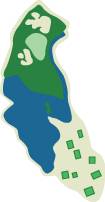
Anthem Country Club
1 Club Side Drive, Henderson
The hole: No. 17.
185 yards, Par-3
Hazards make this par-3 tough to post a score on. A two-tier green is guarded on the right by a stream and stone retaining wall, and two bunkers protect the green on the left. Golfers are advised to aim tee shots to the left to avoid the water hazard or a difficult chip from the desert over the wall. The course includes mountain views, six lakes, waterfalls and natural desert terrain.
-

Bali Hai
5160 Las Vegas Blvd. South, Las Vegas
The hole: No. 16
141 yards, Par-3
It’s called the Pacific Rim and labeled Bali Hai’s most beautiful — and daunting — hole. The island green of this par-3 calls for a chip shot over water and onto heavily sloped greens. The green is protected by bunkers.
-

Bear’s Best Las Vegas
11111 W. Flamingo Road, Las Vegas
The hole: No. 18.
463 yards, Par-4
The last hole on this Jack Nicklaus-designed course has water and sand guarding the right side of the green. It is backdropped with palm trees and a bunker to the left, meaning there are plenty of chances to lose a shot or two at the end of a round. And when you make it onto the green, there’s a three-tier green that presents another challenge.
-

Boulder City Golf Course
1 Clubhouse Drive, Boulder City
The hole: No. 17
186 yards, Par-3
The tree-lined fairways and native plants at Boulder City’s municipal course create a serene setting for a day on the links. The course is nestled among three mountain ranges. Rates are as low as $20 with a cart, and at 6,660 yards, this par-72 course yields friendly scores. A water hazard on No. 17 presents the stiffest challenge, but avoid the water on your tee shot and a birdie is obtainable.
-

Cascata Golf Course
One Cascata Drive, Boulder City
The hole: No. 14
434 yards, Par-4
A creek cuts in front of the tee box and down the right side of this hole to create a significant challenge. It’s also a stunning view. Two bunkers guard the green and give little room for error on the approach shot. There’s also a pond about 100 yards from the green. (Tiger Woods once was photographed there for the cover of “Golf Digest.”) This exclusive course has $500 green fees with priority tee times for Caesars Entertainment hotel guests.
-

Coyote Springs Golf Course
3100 NV-168, Coyote Springs
The hole: No. 14.
413 yards, Par-4
It is considered one of the toughest holes in Southern Nevada in which to post an under-par score. Coyote Springs officials say a par on No. 14 likely will win the round. The undulating green takes your ball on a journey if you aren’t careful, forcing scores to spike with multiple putts. The Jack Nicklaus-designed course, about an hour north of Las Vegas on U.S. 93, opened in 2008 and is rated one of Southern Nevada’s top courses.
-

Las Vegas National
1911 E. Desert Inn Road, Las Vegas
The hole: No. 18
538 yards, Par-5
Get out your driver for this dogleg-right, long par-5. The green is protected by water to the right and bunkers to the front, left and right. The course, previously known as the Sahara Country Club, dates to the 1960s. The Rat Pack frequently golfed there and visited the bar. In 1996, Tiger Woods won his first PGA Tour victory here.
-
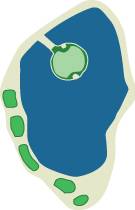
Las Vegas Paiute Golf Course
10325 Nu-Wav Kaiv Blvd., Las Vegas
The hole: No. 15 on Wolf Course.
182 yards, Par-3
Each year, about 20,000 balls are lost in the water hazard guarding the island green. “It has a way of bringing out the worst in people’s swing,” said Tom Fisher, the course’s PGA professional. “It tenses people up. They try too hard.” The hole resembles No. 17 at TPC Sawgrass, notoriously one the toughest holes on the PGA Tour.
-

The Legacy Golf Club
130 Par Excellence Drive, Henderson
The hole: No. 10.
172 yards, Par-3
Each tee box on No. 10 is shaped in a playing card suit — club, diamond, heart and spade.
-

Reflection Bay Golf Club in Lake Las Vegas
75 Montelago Blvd., Henderson
The hole: No. 8.
199 yards, Par-3
One of five holes on the Lake Las Vegas shoreline, No. 8 includes beaches, bunkers and palm trees in the backdrop. Each hole on this high-end public course features views of a 320-acre man-made lake. The course, built in 1998 by Jack Nicklaus, was featured in a Tiger Woods video game.
-
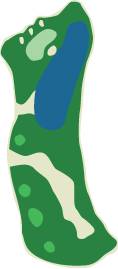
Rhodes Ranch Golf Club
20 East Rhodes Ranch Parkway, Las Vegas
The hole: No. 3.
227 yards, Par-3
The long par-3 is intimidating, with a waterfall pouring into a lake to protect the right side of the green and a bunker directly in front of the green. That puts high demand on an accurate tee shot. Once on the green, putts are considered difficult because of the pace of the greens.
-

Rio Secco Golf Club
2851 Grand Hills Drive, Henderson
The hole: No. 11.
478 yards, Par-4
The elevated tee box overlooks the Strip, yielding one of the best views from a golf course in the valley. But the rest of the course isn’t as relaxing. Because it’s a canyon hole, swirling winds are a challenge. And the fairway is narrow, easily forcing the ball out of play.
-

Royal Links Golf Club
5995 Vegas Valley Drive, Las Vegas
The hole: No. 4.
621 yards, Par-5
The sheer length, combined with frequent windy playing conditions, make this a challenging hole. The left side features trees and out of bounds; the right side is 1 1/2 feet of rough and a sand trap guarding the green. The green isn’t forgiving because it slopes away in many directions. All of Royal Links’ holes resemble those from the British Open, which rotates between 11 courses in Europe. This hole was inspired by No. 8 at Royal Liverpool Golf Club at Hoylake in England.
-
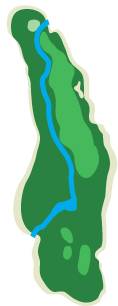
Shadow Creek Golf Club
3 Shadow Creek Drive, North Las Vegas
The hole: No. 15.
438 yards, Par-4
The course was built on 350 acres by Steve Wynn in 1989 for invited guests of the Mirage. Now operated by MGM Resorts International, Shadow Creek remains exclusive and is available only to hotel guests for a $500 green fee. The course includes streams, hillsides and waterfalls, and exotic birds easily are spotted. A creek runs down the left side of No. 15 and across the green. Players hit back into mountains and toward one of the best views from a Las Vegas golf course.
-
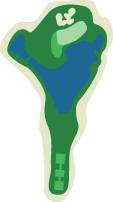
Southern Highlands Golf Club
1 Robert Trent Jones Lane, Las Vegas
The hole: No. 17
214 yards, Par-3
It’s called the Pacific Rim and labeled Bali Hai’s most beautiful — and daunting — hole. The island green of this par-3 calls for a chip shot over water and onto heavily sloped greens. The green is protected by bunkers.
-

TPC Summerlin
1700 Village Center Circle, Las Vegas
The hole: No. 17.
196 yards, Par-3
The first hole-in-one to end a PGA Tour event happened at this hole in 2010 when Jonathan Byrd aced No. 17 in a sudden death playoff during the Shriners Hospital Open. Byrd sunk the ball with a six-iron, while the shots of the two other golfers landed in the water guarding the left side of the green. A bunker also sits on the right, forcing an accurate tee shot to record a respectable score. This hole typically produces the most excitement of any round at TPC Summerlin. Plus, golfers tee off on an elevated tee box with amazing views.
-

TPC Vegas
9851 Canyon Run Drive, Las Vegas
The hole: No. 14
465 yards, Par-4
Affectionately called the “Steeple Hole” because golfers aim their tee shot toward the steeple of a nearby church, TPC’s No. 14 is widely considered one of the best par-4s in Las Vegas. Players are advised to hit tee shots to the right side of the green, which gives a manageable 100-yard shot onto the green. Hit to the left of the steeple, and your ball will have to carry over a ridge.
-

Wynn Golf Club
3131 Las Vegas Blvd. South, Las Vegas
The hole: No. 18.
425 yards, Par-4
This is one of the city’s best 18th holes. The view can’t be beat. A $2 million cascading 37-foot waterfall behind the 18th green is a perfect setting to finish a round. There also is a view of the Las Vegas skyline. Water comes into play on the left side of the fairway, with 4,600 lineal feet of stream and two marshland areas with natural groundwater. Formerly the Desert Inn Golf Club, the course was rebuilt in 2005 and designed by Tom Fazio and Steve Wynn. It costs $500 per round.
Bargain stops
Nine holes, four clubs and less than two hours. That was my morning at North Las Vegas Golf Course, a par-3 that measures a little more than 1,000 yards and is one of the valley’s most affordable golf escapes.
Walk on for less than $10 on a Friday morning. The course works as well for those just learning the game — my playing partner started her first-ever round here as a child — or those used to a full 18-hole course who want to work on their short game.
The course, owned and operated by the city of North Las Vegas, opens at 6 a.m. and offers lighted late-night hours in the summer, when keeping your eye on the ball can be as important as the swing. I used a 9-iron, pitching wedge, lob wedge and putter, though a few holes tested those limits.
Lessons are available for beginner and intermediate children and adults, and the pro shop offers clubs children can use free of charge.
— Taylor Bern
The heat took hold on hole No. 15.
When you’re playing a golf course with furnace in its name, it’s a question of when, not if, that happens.
I’m not a good golfer even in perfect conditions, so the scorecard, ugly all day, didn’t betray my secret. It simply was a feeling inside — that a few hours and 14 holes at Death Valley’s Furnace Creek Golf Course on a day the thermometer revved up to 130 degrees had defeated me.
The last few holes of a course usually provide a shot at redemption, a chance to get in a flush hit that become the only thing you really remember and the thing that keeps you coming back. This trip offered no such safety net.
Furnace Creek, part of a resort in Death Valley National Park about two hours from Las Vegas, claims to be the world’s lowest grass golf course. It sits 214 feet below sea level, and from June to October, the rate drops to $30, including a cart.
That’s a great deal to play a beautiful course. The catch? Wide-open desert fairways under a scorching sun that tests durability and conditioning as much as skill.
Dealing with heat is part of golfing in Las Vegas. Hot is hot, or so I thought. But when the heat index creeps past 120, you’re entering a whole new level.
Hydration, of course, is critical, but no matter how much liquid you consume, it doesn’t feel like enough. Drinking an entire bottle of water or dumping it on your head offers the same result, because you’re never not drenched in sweat.
Part of Furnace Creek’s appeal is testing your mettle in the heat. Merely completing the round felt like an accomplishment.
I recommend taking the challenge at least once. Circle the hottest day of the year and step into the furnace.
— Taylor Bern
Tips to avoid common golfer’s injuries
Golf can make for a fun outing with friends or serve as the backdrop for business negotiations. Though overuse is to blame for many professional golf injuries, amateur golfers also can suffer injuries due to poor conditioning or improper technique. Injuries to the lower back, elbows and wrists are most common in golf, but shoulder, knee and hand injuries also can occur. Strengthening your body and learning proper form can keep you healthy — and improve your swing.
Back
Lower back strains are the most common golf injury. Though golfers may try to rotate their pelvis and trunk separately for the sake of a powerful swing, the torque can cause serious damage. Rotating your hips and shoulders together is safer. Increasing your flexibility and muscle strength also can help prevent back injuries. Gluteal muscles take pressure off your lower back, so strengthening them can help keep your back in good working order.
Elbow
Elbow injuries are common for amateur golfers. Women are particularly vulnerable because of their physiology, in particular the angle of their elbows. Golfer’s elbow is pain on the inner side of the elbow, while tennis elbow, which also can occur in golf, is pain around the outside of the elbow. Both tend to get worse with frequent play and as players get older. To keep your elbows healthy, minimize tension in your swing by gripping the club lightly. Also, during your backswing, when the club head passes your back foot, your right arm should bend at the elbow in a quick, controlled motion to prevent unnecessary strain.
Knees
Squaring your lead foot and locking your knee can exert force on your knee joint. That force, plus the impact of shifting weight in the downswing, can cause damage to the joint, leading to arthritis or cartilage damage. Instead, make sure your knee shifts in front of your hip early in the downswing and rotate your hips to ensure as little unnecessary pressure as possible on the joint.
Hand/wrist
Wrists and hands can be injured during impact if a golfer hits something other than the ball, such as the ground, during a swing. The impact changes the force applied to the club. In addition, beginning golfers who unlock their wrists while swinging downward cause a flinging motion, which in addition to causing a less forceful, less controlled shot, can put pressure on their wrists and cause injury. Wrist injuries such as chronic tendinitis also can arise when swing technique or grip changes, especially when excessive use also is a factor.
To help prevent such injuries, build forearm strength with exercise, especially in your lead wrist. Also, practice your swing and grip.
Shoulders
A golfer’s lead shoulder is expected to have a large range of motion in a golf swing. Overuse can lead to small shoulder injuries, which can build up to bigger injuries.
Common injuries include rotator cuff problems, tendinitis, arthritis and bursitis, or inflammation of the fluid-filled sacs between bones and soft tissues. To keep healthy, remember to rotate your body as you swing backward, rather than just move your arms. During the downswing, your arms should move with your body rather than be forced down by your shoulder muscles. Practice keeping your knees bent during the downswing to prevent your shoulder from coming out of sync. Keeping your body in sync helps prevent excessive strain and allows you to maintain optimal body angles.
How to remain injury-free
Warm up for at least 10 minutes before golfing.
Gradually increase the length and intensity of golf games each season.
Perfect your stance. Stand with your feet shoulder-length apart with knees semi-bent. Shoulders should be square to the ball.
Avoid overuse. Repetition may be important to mastering your swing, but keep in mind your body’s limitations.
Focus on body alignment and posture. Find a grip that feels comfortable and try to strengthen your core.
— Pashtana Usufzy


















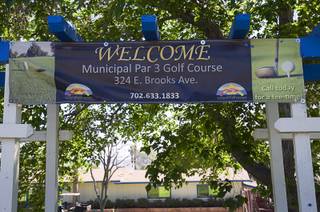

Join the Discussion:
Check this out for a full explanation of our conversion to the LiveFyre commenting system and instructions on how to sign up for an account.
Full comments policy